IPv6 and /etc/resolv.conf
-
Hello fellow, pfsense users and community members can you please help?
I have noticed that the resolved.com file seems to be missing the IPv6 loop back.
For pure IPV6 to function inside of squid proxy should this also contain a loop back for IPV6? Well researching I have noticed the dns_nameservers directive for squid utilizes this file.
Currently, I could not get IPv6 only clients to function with squid however they would function if I removed squid from the equation hence isolated it to a squid configuration issue for DNS resolving as the errors are 409 errors dual stack clients do not have this issue as if the system only accepts requests from IPV4 two IPV6 websites. therefore IPv6 only clients cannot access web traffic but IPv4 clients can access IPv6 sites. If I make an any any rule IPV6 clients can access anything so it is not pfsense that is configured wrong it is the Squid package.
I suspect that for IPv6 only clients you must also utilize the dns_nameservers directive.
Has anyone else seen this?

-
As quoted from Squid The Definitive Guide by O'Reilly Duane Wessels
"By default, squid sends DNS queries to the name servers listed in the /etc/resolv.conf file. If you want squid to use a different set of name servers, you must specify them with this directive."
-
@JonathanLee why would you think what your talking to locally for dns when something asks your proxy to go to somewhere.domain.tld would have to talk to ipv6 link local or some other ipv6 dns to work?
you can for sure resolve AAAA over IPv4.. There is little need for your local to local communication to use ipv6 to resolve dns.
Sure your ipv6 only client can talk to the proxy via IPv6.. But how the proxy actually looks up somewhere.domain.tld that the client is asking for sure doesn't have to also be done over ipv6 be that the proxy just asking the local dns on the machine its running, or some other NS not on the host the proxy is running.. It just needs to be able to talk to it.
But yeah if they are going to start adding ::1 as a local NS, they should prob show that in resolv.conf as well.. There have a been a few threads lately related to that new ::1 you see in NS listed in pfsense on the widget, and timeouts, etc. in the web diag dns lookup gui, etc.
-
@johnpoz thanks for the reply. Currently.it will not work with the current configuration and I suspect that it has to do with DNS as it will show 409 errors for IPV six only clients. my question is now I'm attempting to utilize this directive and I don't know what else to put in there so that the system will use this socket.
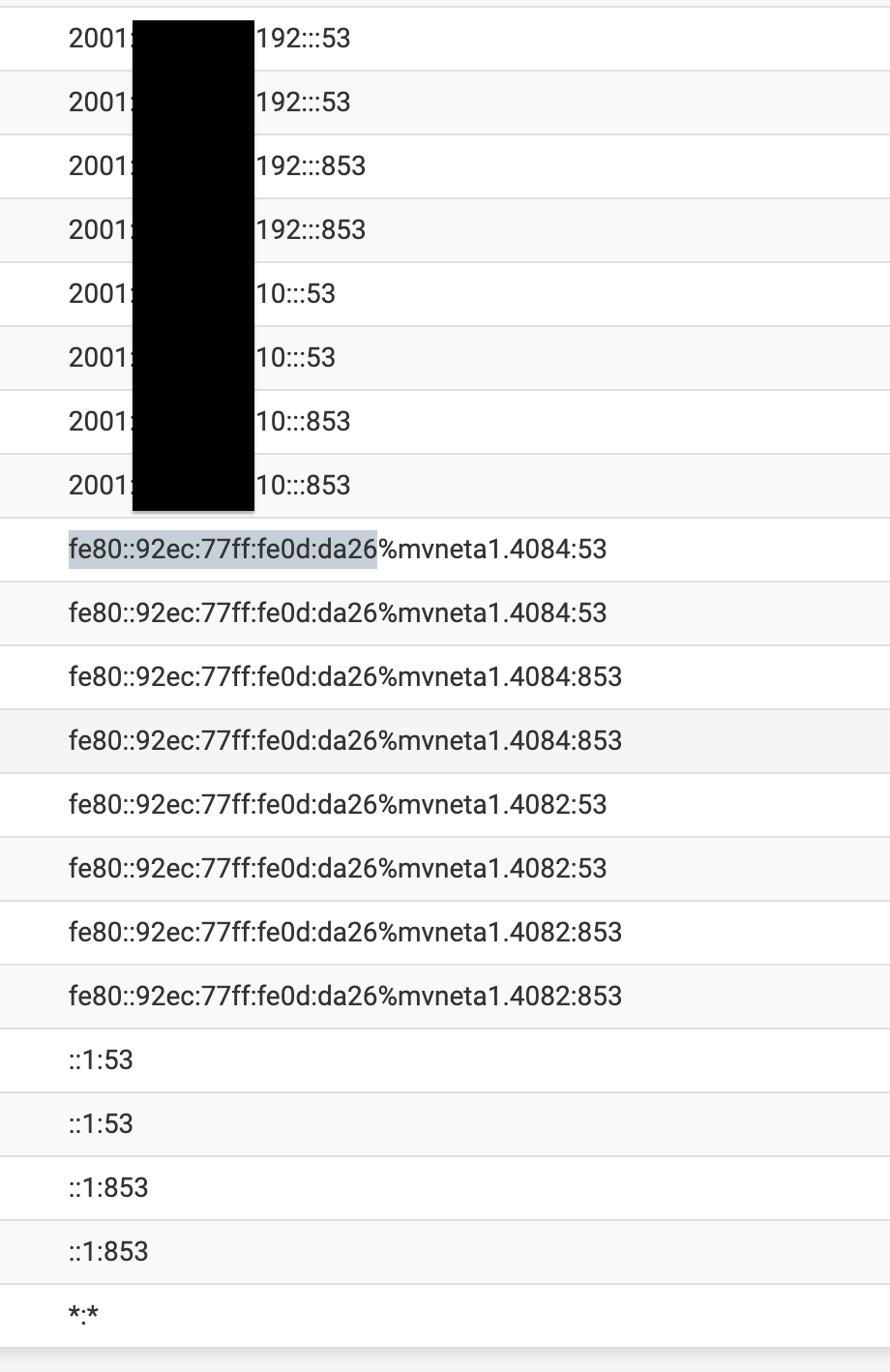
::1:53?
fe80:
dns_nameservers 127.0.0.1 192.168.1.1 2001:redacted:192::If I remove squid IPv6 clients work perfectly, suspect it has to do with the resolver settings inside of squid.
Just for a quick test, what would I? What would you put in there for that directive?
-
Here is what i get.

-
@JonathanLee what is that even from? You going to show some info - you need to state where you got that info..
All that is IPs to 53 dns and 853 (dot)
Is that your client trying to go there?
Again that would have ZERO to do with what is in your resolve.conf - because clearly your resolve.conf only has 127.0.0.1 and none of that is going there - so clearly it didn't read it from your resolv.conf file.
-
@johnpoz That is from diagnostics sockets showing that there is pfsense listening going on for the DNS port.
-
@JonathanLee again so? what does that have to do with price of tea in china or your issue? Let see oh yeah nothing ;)
-
@johnpoz I can't get squid to resolve ipv6 only to ipv6
it resolves ipv4 to ipv6 only.
I see the attempts hit the proxy on ipv6 and go to 409 errors. So I showed the sockets to help isolate that there is in fact something listening on ipv6.
(/assets/uploads/files/1722377486648-screenshot-2024-07-30-at-13.37.40.png)
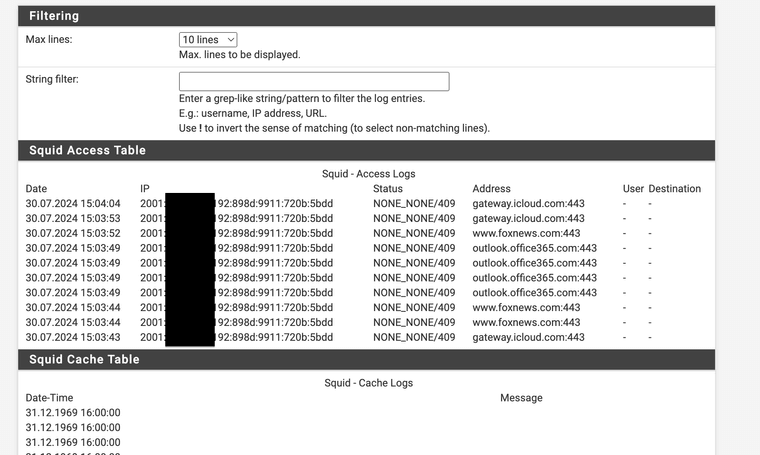
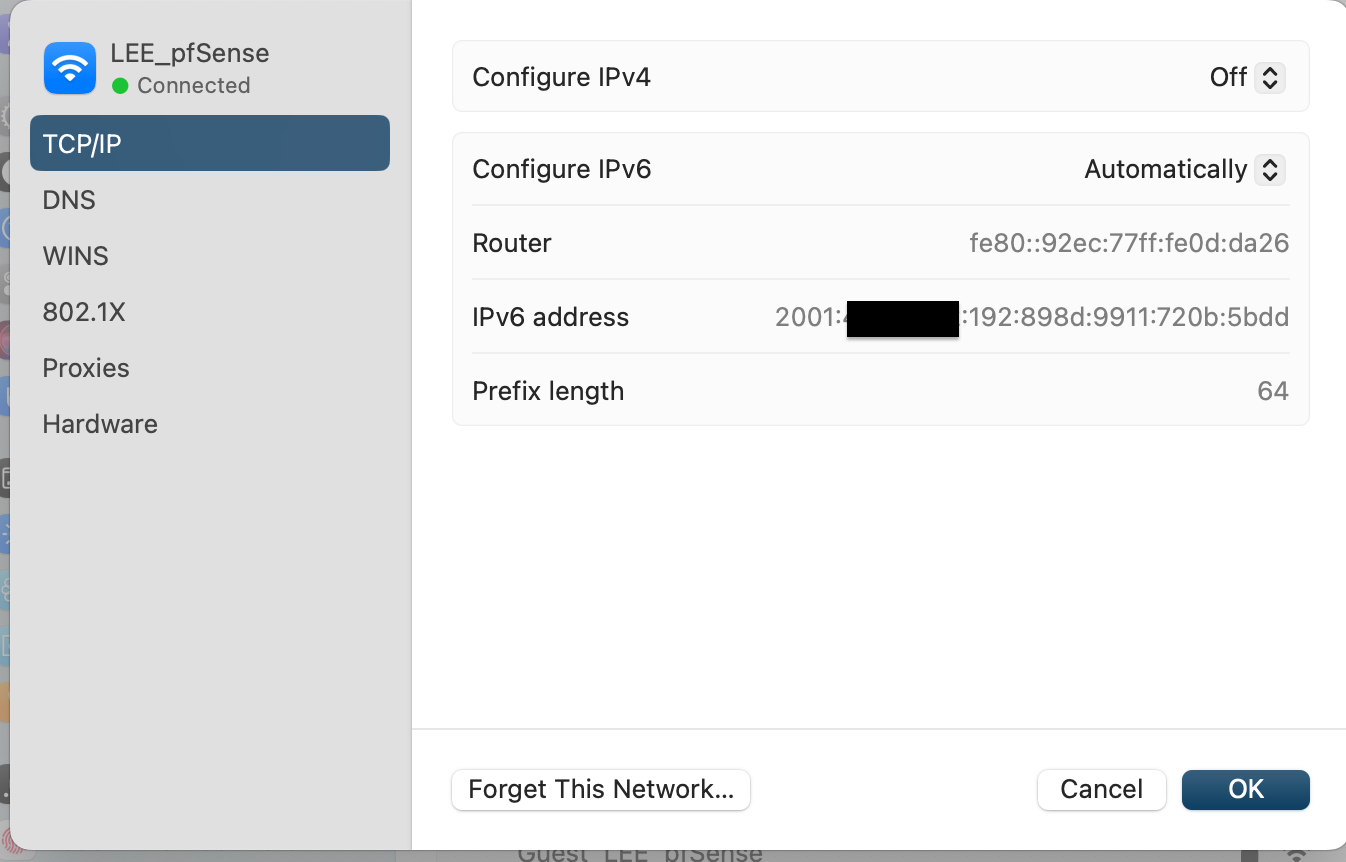
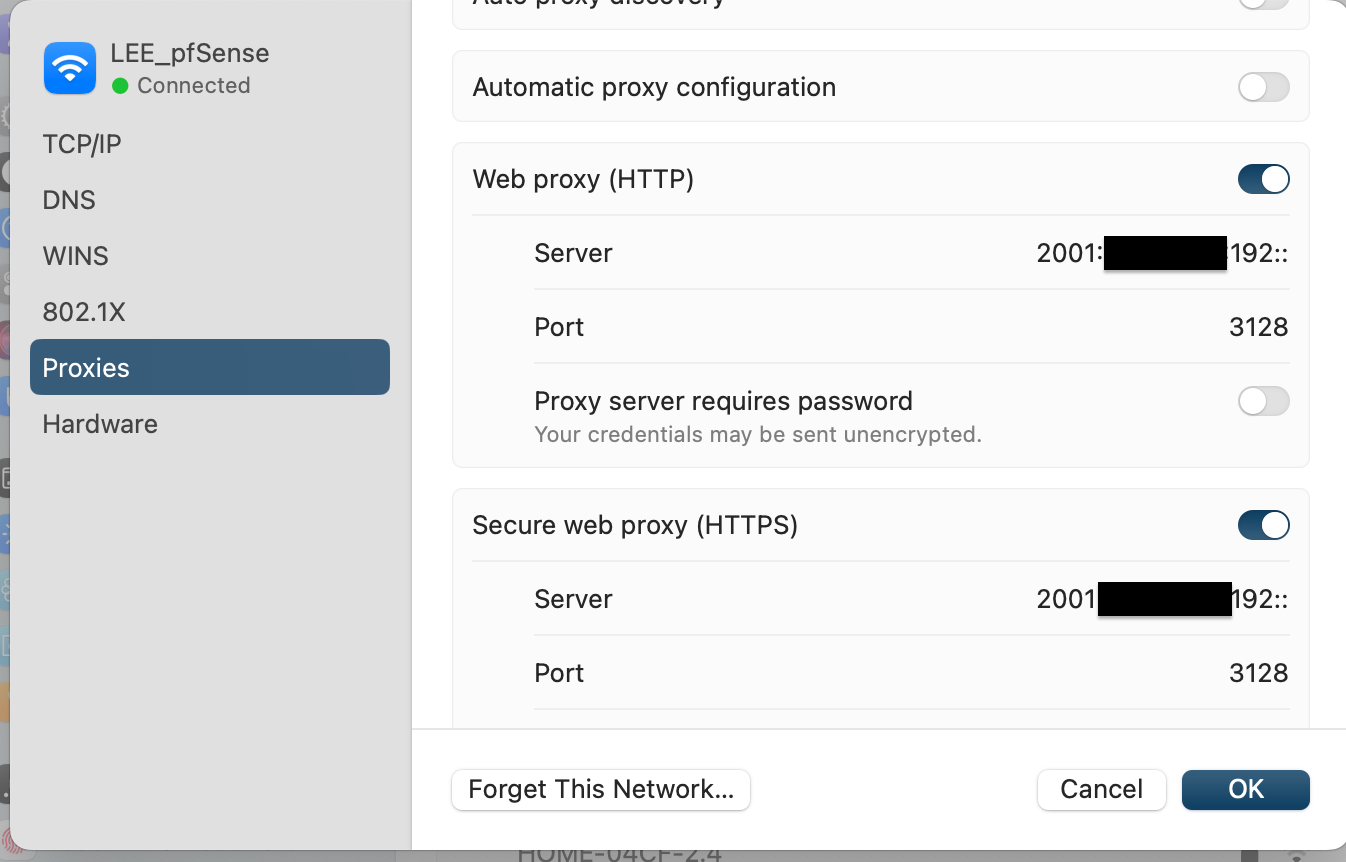
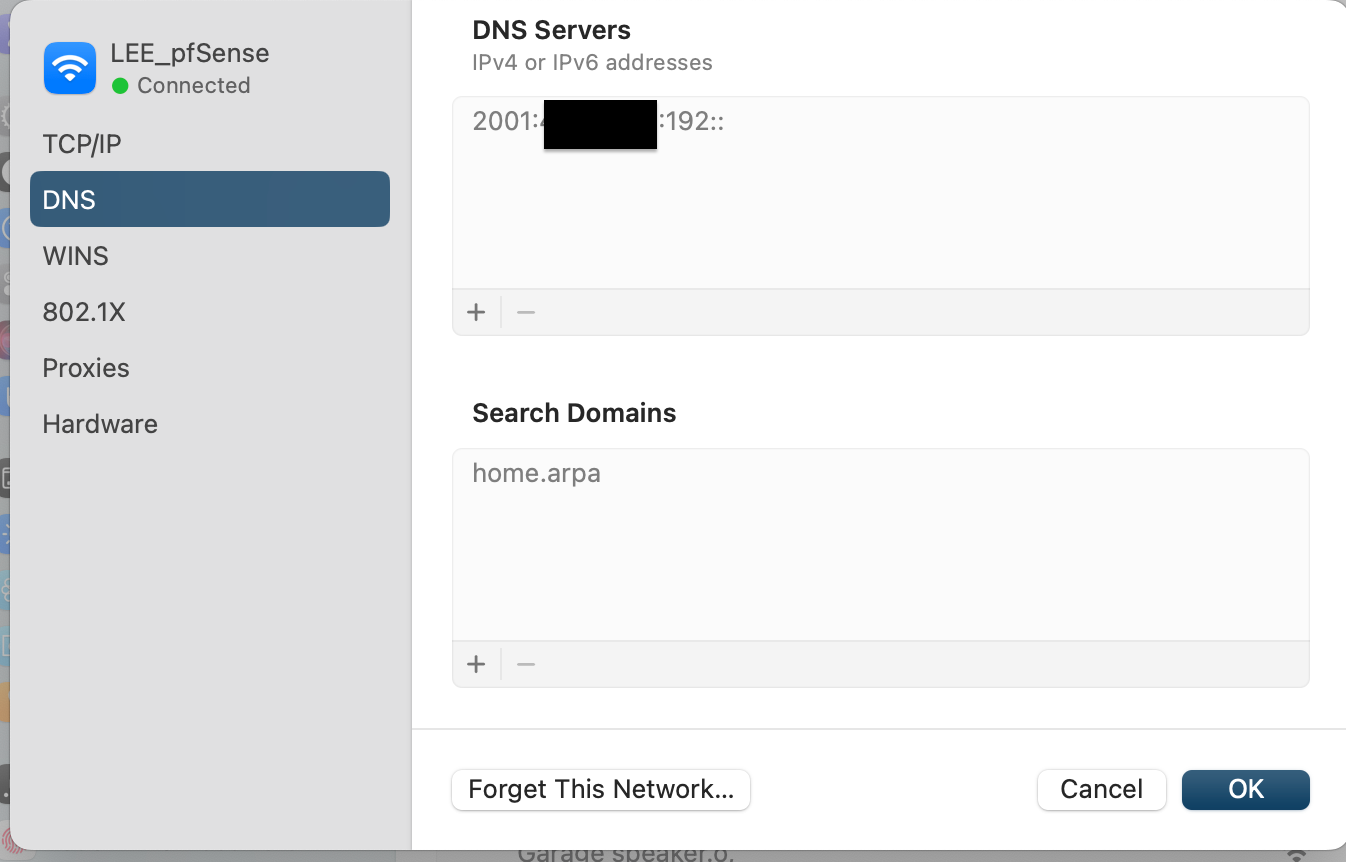
Everything is set if i use no proxy it works pure ipv6
-
@JonathanLee Why are you even setting a dns when your client is explicitly pointing to a proxy?
When a client points to a proxy explicitly its not the one doing dns..
Where did you come up with that address for dns? :: would be the network address more than likely.. Not a host address..
2001:xxxx:xxxx:192::/64 or 2001:xxxx:xxxx:192:0:0:0:0 is the wire, not a host.
Can pfsense even talk to the internet via IPv6.. Can you ping say ipv6.l.google.com which resolves to 2607:f8b0:4009:819::200e
Those are all 443 sites its trying to go to.. so your splicing? This thread doesn't belong in IPv6 - it belongs in the proxy section, moving...
-
 J johnpoz moved this topic from IPv6 on
J johnpoz moved this topic from IPv6 on
-
Thanks for the reply IPv6 is like a new motorcycle that you want to test out on every path to me.
Ping6 with dual stack enabled pfsense plus 24.03
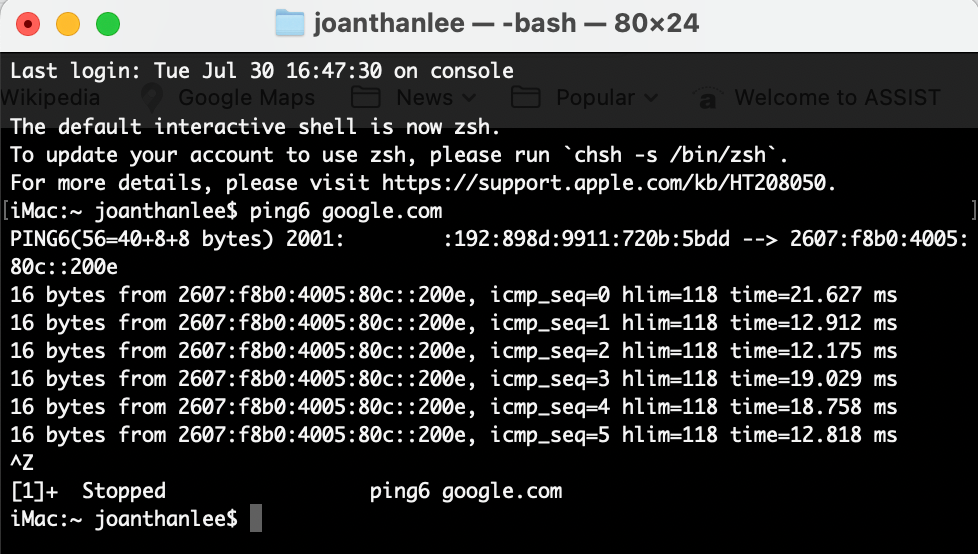
You mention that I can't point to the network.. did I assign the interface subnets incorrectly?

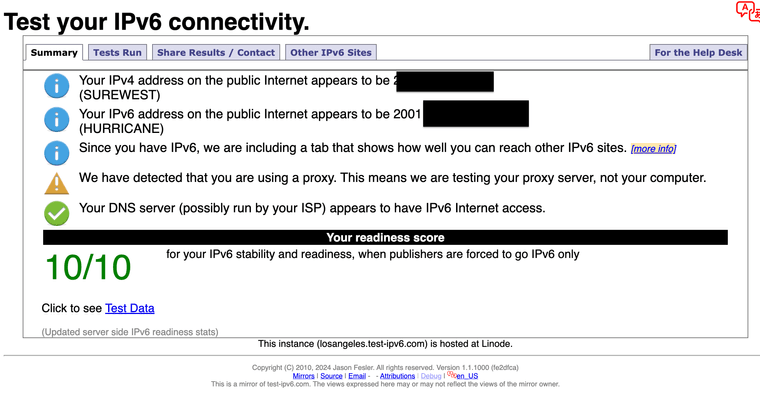
Did I configure the /48 subnet into 2 networks incorrectly on the static assignments on the interfaces? Should it not be the wire?
-
@johnpoz Why is it allowing me to assign the full wire and or network to the interface as a host address? If it allows this that could cause issues with other items also, should this be part of error handling, what is weird is it works, everything works like this. Could something be spoofed and have the wire address assigned to it? that could cause confusion..
Should the interface static address be the wire or prefix with::10 or something? If I do subnet::1 I loose my full dhcp range
-
@JonathanLee Man its a been awhile since done anything with this, because I just use an actual host address ::253 which lines up with my IPv4 address on the pfsense interface.
But I believe all zeros like that :: considered the anycast address with IPv6. And believe is valid is why they don't throw up a warning..
I believe rfc5375 is what you prob want to look at..
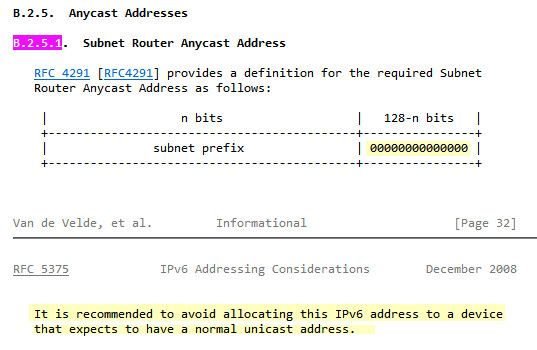
I would think a "proxy" would want a normal unicast address.
Maybe that is causing you some issues? And I think there is something when doing splits and differences in NS used by the proxy and the client..
If me I would put a normal unicast host address on your interface.. I am not a big proxy user, I use to do it for a living back in the day.. Ran global web filtering for a fortune 500 company.. And have used pretty much every proxy under the sun.. But I got out of that many years ago and really only do actual networking now. Routing and switching..
Reason I moved this to the proxy section, this isn't specific an issue with IPv6 in routing or firewalling or even dns.. You more than likely will find someone else here doing proxy with IPv6 that will be better help than me.
-
-
@JonathanLee so its working now? Yeah that is kind of good idea, use the port your using for proxy ;) hahah
I believe I have mentioned this before.. I line up the IPv6 addresses I do use on my network (play and test) to match..
So my IPv6 /48 from HE 2001:470:xxxx:xxxx::/48 I turn that into my /64 by making the 5th segment match so my /64 would be
my lan IP192.168.9.253/24
2001:470:xxxx:xxxx:9::253/64Another segment of mine
my dmz IP192.168.3.253/24
2001:470:xxxx:xxxx:3::253/64My roku vlan 192.168.7.253/24
2001:470:xxxx:xxxx:7::253/etc.. My main pc on my lan is
192.168.9.100/24
2001:470:xxxx:xxxx:9::100/ -
@johnpoz how do you assign a dhcp range if you don mind me asking? I set my interface to end in :1 and my range was all messed up.
"For example, use 2001:db8:1111:2222::1 for the LAN IPv6 address if the Routed /64 is 2001:db8:1111:2222::/64."
"Enter a range of IPv6 IP addresses inside the new LAN IPv6 prefix"
So in my case
2001:xxx:xxxx::192:: - 2001:xxxx:xxxx:192:ffff:ffff:ffff:ffffI want 2001:xxxx:xxxx:192:168:1:1:a for my interface so i could set my range as
2001:xxx:xxxx:192:168:1::-
2001:xxx:xxxx:192:168:1:ffff:ffffI am going to have to recreate all my static assignments now
-
@johnpoz same issue with the recommendations. I went as far this time to disable IPv4 on the proxy server itself and get a pcap file it is like the proxy doesn’t know where to forward the traffic. It is weird
-
@JonathanLee well couple things I notice about what you listed there with your 409 errors. They are all cnames, and they have round robin answers on the cname, ie multiple IPs.
And can tell you right now that foxnews one is never going to work because it doesn't have a IPv6 address. So no if trying to do IPv6 with that its never going to work..
My opinion with IPv6 and proxy, just like normal IPv6 is its not really ready for prime time.. There are vast amounts of major player sites that don't even have IPv6 versions. Your going to run into issues - how the client normally handles it is dual stacked, and something that doesn't have IPv6 it uses IPv4.. it makes the switch on its own.. etc..
When doing splice you can have issues with when the host name not matching, etc..
You could also be running into issues with browser doing doh on its own.. And getting different responses for dns, etc..
Personally I wouldn't if you really want to proxy, even allow clients to use IPv6.. Its not like its a requirement or anything.. Can you name one major resource that requires IPv6? Just 1?? Not talking about some guys personal website he is hosting only on ipv6 because his isp doesn't have IPv4 address space to give to clients or they use cgnat, etc.
-
@johnpoz said in IPv6 and /etc/resolv.conf:
Can you name one major resource that requires IPv6? Just 1??
Let me think .... => got it : Humanity !?!

-
Thanks for the clarification because it works perfectly with dual stack. This was more of a can I make some clients only IPv6. But when in dual stack it only works IPv4 clients to IPv6 sites and never IPv6 to IPv6. I enabled pure IPv6 and Squid terminates with this error..
The error it shows when I activate IPv6 only mode not dual stack is
Error: no forward proxy ports configured
Squid terminated
The errors in the pcap act like they require a udp 443 I have DoH blocked for major DoH servers. Again that is like wack a mole. The IPv6 only works once the proxy is removed. So the error is isolated into Squid. I have tested old packages and knew they seem to have the same issues. I was reading it might require SLLAC enabled and I currently have it set to managed. I might test this out today. Goal is to have it work with IPv6 only mode and proxy traffic.
Some users also added this to the configuration.
acl localnet src fc00::/7
acl localnet src fe80::/10
